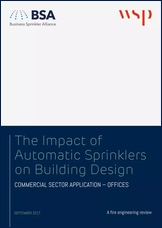The impact of automatic sprinklers on building design
The Impact of Automatic Sprinklers on Building Design: A fire engineering review, is an independent report produced by WSP, sponsored by the Business Sprinkler Alliance (BSA). It was published in September 2017.
The report aims to raise awareness of the beneficial impact of automatic sprinkler systems, and provides those involved in the design and construction supply chain with useful information about design implications. It gives the reader an appreciation of whether the inclusion of automatic sprinklers for a particular scheme is worthy of further consideration.
Automatic sprinkler systems extinguish or control fires by discharging water locally. Sprinkler systems consists of water supply (tank, pump and valves) and sprinkler installation (pipes and heads). Detection is handled mechanically by heat sensitive elements that can be constructed from soldered links or glass bulbs containing oil based liquids. The thermal element holds in place a plug which prevents water from flowing from the sprinkler head. The thermal elements respond to localised heating which releases the plug and allows water to flow.
Key facts about operation include:
- Automatic sprinklers will typically only operate in areas where fire is present allowing adjacent rooms or areas to remain unaffected.
- Discharge in the presence of fire is extremely reliable (98 to 99.8%) and discharge in the absence of fire is rare.
- Sprinklers have an 80-95% probability of being successful.
- Generally cost and design complexity increases with fire risk.
- Systems can be designed to conceal pipes, and the availability of decorative sprinkler heads allows them to be matched with the interior of the space.
The installation of an automatic sprinkler system can reduce the risk to life and the degree of damage caused in a fire event. As a result, it may be possible to reduce other fire protection measures.
The report focuses on the commercial and design impacts of automatic sprinklers rather than fire safety, exploring the ways automatic sprinklers can add value to building design, including:
- Net capital cost savings.
- Increasing the net internal area / building efficiency.
- Improving design flexibility and creating architectural freedom.
- Reducing the construction programme and/or simplifying site works.
Automatic sprinklers can permit:
- Larger compartment sizes.
- Reduced structural fire protection requirements.
- Increased travel distances leading to possible design freedoms such as the removal of stairs.
- Reduction in fire-fighting shafts.
- Reduced circulation areas leading to increased useable area.
The report supports the view that automatic sprinklers should be considered early in the design process and dispels myths about cost and design freedom. It provides an introduction to sprinklers, an overview of design and operation, and considers areas of design impact, fire protection costs and commercial applications for offices.
The first section of the report discusses concessions allowed by standard fire safety guidance for a variety of building types if automatic sprinklers are incorporated. The second section provides a review of office building types and key objectives relevant to them.
[edit] Related articles on Designing Buildings
- Automatic fire sprinkler.
- Automatic fire sprinkler systems: A good practice guide.
- Business Sprinkler Alliance.
- Case study A for offices to show where automatic sprinklers have the greatest impact.
- Case study B for offices to show where automatic sprinklers have the greatest impact.
- Costs of water automatic sprinkler systems.
- Design benefits of automatic sprinkler systems granted under approved document B.
- Drenchers.
- Fire detection and alarm system.
- Fire detector.
- Fire in buildings.
- Fire protection engineering.
- Fire safety design.
- Making the case for sprinklers and dispelling myths.
- Overview of automatic sprinkler system design and operation.
- Sprinkler head.
- Sprinklers.
- Sprinkler systems explained: A guide to sprinkler installation standards and rules.
- The cost efficiency of different combinations of fire protection measures.
- Watermist systems for fire protection in domestic and residential buildings DG 534.
Featured articles and news
Government consultations for the summer of 2025
A year of Labour, past and present consultations on the environment, the built environment, training and tax.
CMA competitiveness probe of major housing developers
100 million affordable housing contributions committed with further consultation published.
Homes England supports Greencore Homes
42 new build affordable sustainable homes in Oxfordshire.
Zero carbon social housing: unlocking brownfield potential
Seven ZEDpod strategies for brownfield housing success.
CIOB report; a blueprint for SDGs and the built environment
Pairing the Sustainable Development Goals with projects.
Types, tests, standards and fires relating to external cladding
Brief descriptions with an extensive list of fires for review.
Latest Build UK Building Safety Regime explainer published
Key elements in one short, now updated document.
UKGBC launch the UK Climate Resilience Roadmap
First guidance of its kind on direct climate impacts for the built environment and how it can adapt.
CLC Health, Safety and Wellbeing Strategy 2025
Launched by the Minister for Industry to look at fatalities on site, improving mental health and other issues.
One of the most impressive Victorian architects. Book review.
Common Assessment Standard now with building safety
New CAS update now includes mandatory building safety questions.
RTPI leader to become new CIOB Chief Executive Officer
Dr Victoria Hills MRTPI, FICE to take over after Caroline Gumble’s departure.
Social and affordable housing, a long term plan for delivery
The “Delivering a Decade of Renewal for Social and Affordable Housing” strategy sets out future path.
A change to adoptive architecture
Effects of global weather warming on architectural detailing, material choice and human interaction.
The proposed publicly owned and backed subsidiary of Homes England, to facilitate new homes.
How big is the problem and what can we do to mitigate the effects?
Overheating guidance and tools for building designers
A number of cool guides to help with the heat.
The UK's Modern Industrial Strategy: A 10 year plan
Previous consultation criticism, current key elements and general support with some persisting reservations.
Building Safety Regulator reforms
New roles, new staff and a new fast track service pave the way for a single construction regulator.


























